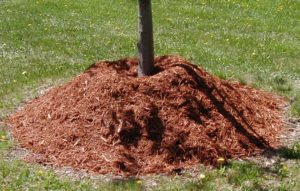Mulching is one of the best ways to maintain a healthy landscape. When properly applied, mulch can serve as an excellent substitute to the organic materials and other living organisms commonly found in a plant’s natural environment. These nutritional components are vital to any plant’s growth, but in urban settings, they are not quite as abundant. This makes mulch a pivotal resource. The following is an overview of the benefits of mulch, and how it can properly applied to any landscape or garden.
What is Mulch?
Mulch is a protective layer of material that is placed over the soil surface of a tree or shrub. It is generally used to help maintain soil moisture, and improve overall soil conditions.
Types of Mulch:
Mulch is available in many different forms, each of which are categorized into two major types: organic and inorganic.
Organic Mulch
Organic mulch is a type of mulch product that has been derived from plant material. This includes mulch that is made from wood chips, grass clippings, pine needles, leaves, bark nuggets, cocoa hulls, hay, or compost mixes. Organic mulch is nutritionally beneficial to trees and gardens. It gradually decomposes, improving the quality and fertility of soil. This promotes root growth, and assists in mineral uptake. Because it decomposes, organic mulch needs to be replenished over time, requiring additional maintenance.
Inorganic Mulch
Inorganic mulch is a type of mulch product that is derived from nonliving material. This includes any mulch that is made from stone, gravel, lava rock, pulverized rubber, plastic, or geotextile fabric. Inorganic mulches contain no nutritional value, and do not improve soil structure. As such, they are generally used either for aesthetic purposes, or to suppress weeds, and other invasive plants. Due to the nature of their design, inorganic mulches do not decompose, and often do not need to be replenished, making for a cheaper alternative to organic mulch.
Benefits of Proper Mulching:
Proper mulching is a practice that can significantly improve the quality of any landscape or garden. These are some of its many benefits:
- Proper mulching can help reduce the amount of soil moisture lost through evaporation.
- It can inhibit soil borne pathogens, and prevent the development of certain plant diseases.
- It moderates soil temperature, preventing extreme temperature fluctuations.
- It insulates plant roots from cold weather, and potential winter ailments, such as frost-heaving.
- It suppresses weed germination, inhibiting the growth of invasive vegetative plants.
- It can improve the quality, and structure of soil.
- It can improve soil drainage, and aeration.
- Organic mulch decomposes, contributing organic matter back into the soil.
- It offsets the potential for tree damage resulting from lawn mowers and weed whackers.
- It is aesthetically pleasing, lending landscapes, and planting beds a clean, uniform appearance.
Proper Mulching Techniques:
When applying mulch to a landscape or garden, these are some important guidelines to follow:
- Examine the soil type, and determine whether soil drainage is adequate for the application of mulch.
- Determine whether there are any plants present that may be adversely affected by the choice of mulch.
- For well-drained soil, apply a layer of mulch at a depth of 2 to 4 inches (5 to 10 centimeters).
- For clay soils, apply at a lesser depth of around 2 inches.
- For sandy soils, apply at a greater depth of around 3 to 4 inches.
- Apply 10 inches of mulch per every 1 inch caliber. For example: a tree with a diameter of six inches would require a sixty inch mulch bed, measuring thirty inches in circumference.
- If mulch is already present, inspect its depth. If the amount is adequate, refresh its appearance. If any mulch is piled up against a plant stem or tree trunk, pull it back until the base of the trunk or stem is exposed, and remove the excess amount.
- Composted wood chips make for excellent mulch, particularly if they include fragments of bark, pine needles, and leaves. They naturally decompose, improving the quality of soil, and help reduce the potential for certain pathogens.
What to Avoid:
-
The ‘mulch volcanoe’, image by Cornell University. Avoid applying excessive piles of mulch around the base of trees. These are called “mulch volcanoes”. They can attract insects, and promote plant disease; they also encourage the development of girdling roots, which can cause die back.
- Avoid deep mulching; although it can effectively suppress weeds, it can also create stressors for the plant, and promote root rot.
- When reapplying mulch, do not use a different type than what is already present. This leads to layering, which can restrict the movement of water and nutrients to the soil.
- The use of certain mulches, particularly those containing grass clippings, can alter soil pH, causing excessive nitrogen buildup, and leading to nutrient deficiencies.
- Do not use anaerobic mulch. This type of mulch, referred to as “sour mulch,” is known for its pungent odor, and high acidity. If applied, it can quickly lower soil pH, and prove toxic to developing plants.
- Mulch that has not been composted for at least six months can attract bacteria that occur naturally in soil. These bacteria consume the mulch, causing it to break down more rapidly. As they feast, they use up the nitrogen that is present in the soil, which can potentially cause a nitrogen deficiency.



